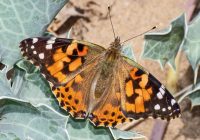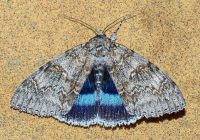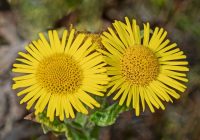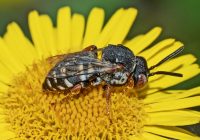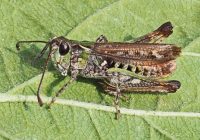Dr Phil Smith’s Wildlife Notes
AUGUST 2025
The almost unprecedented summer drought continued throughout August, Formby receiving only 13mm of rainfall, about 20% of the expected amount. The Met. Office reported the warmest summer on record, beating even the scorcher of 1976. They pointed to high contrasts nationally, with a named storm, heatwaves and drought, all consistent with a warming trend. As expected, the sand-dune water-table fell by 10cm at my Devil’s Hole, Ravenmeols, measuring point.
On 1st, Pete Kinsella joined me at Crosby Coastal Park, a hotspot for duneland insects. It was very windy, so we struggled to find much on the abundant Sea-holly, though I was pleased to see two Beewolf wasps, a Noble Jewel Wasp, a beautifully marked Hook-banded Meadow Fly and a fresh Painted Lady. The following day, with friends, I visited a superb garden at Hillside where the main attraction (for me) is an enormous pond where, since 2013, we have recorded 13 kinds of dragonfly. This time, there were six, including Emperor, Southern Hawker and Brown Hawker.
By mid-month, effects of the drought on our local wildlife were evident; dune vegetation was straw-coloured with few flowers left to act as nectar sources, while Black Poplar leaves at Range Lane were turning golden and dropping. Unsurprisingly, insect numbers and variety collapsed, though there were some highlights. Easily the best of these came out of the blue on 19th when Richard Walker emailed to say he had light-trapped a Clifden Nonpareil at Formby Point and could bring it round in five minutes. This almost mythical giant moth was the Victorian collector’s ‘holy grail.’ Originally found in the 18th century at Clifden (now spelt Cliveden, Bucks.), it became extinct in Britain in the 1960s, only being seen as a rare vagrant, until about a decade ago when it re-colonised the south of England and rapidly spread north. It is still rare in the Northwest and I had never seen one. My O-level French translated “Nonpareil” as “without equal” – very appropriate. I photographed this huge and perfect specimen, with its electric-blue hindwing band, before Richard took it back for release in the dunes.
One of my favourite walks on the outskirts of Formby produced a remarkable count of 22 Dock Bugs, a large insect that has colonised the Northwest in recent years. Also noteworthy was a mating pair of Common Stiletto flies, a Marsh Snipefly and a colourful male Southern Hawker that, typically, flew over to inspect me but didn’t land.
Despite the drought, Ainsdale’s Falklands Way dunes still had some golden stands of Common Fleabane, a magnet for several kinds of hoverfly, including the impressive Wasp Plumehorn and Golden-tailed Leafwalker. Solitary bees were represented by the brightly-patterned Black-thighed Epeolus, a ‘cuckoo’ that lays its eggs in the nests of Plasterer Bees. Red-and-black Six-spot Burnet moths seemed to be unaffected by the dry conditions, being about as numerous as usual but most butterflies disappeared, having had a pretty good season up to this point. By now, the Devil’s Hole was quiet but I did manage to find a mating pair of the Four-banded Beegrabber during one of my regular visits to record the water-table and list the plants for a study that began in 2004. Having added a few new ones during August, the grand total of higher plants for this amazing site is now 186!
Dug out by hand in 1911 as a boating lake, Ainsdale’s Sands Lake is too deep to dry up. Its resident Mute Swans produced three youngsters and I heard a snatch of song from Cetti’s Warbler on 17th, while identifying six species of common dragonflies. The nearby ‘Green Beach’ (another of my long-term studies) provided a spectacular display of Grass-of-Parnassus, a flower that is familiar to us but which is Red-listed ‘Vulnerable’ in England. My friend, the late Trevor Davenport, used to say “You couldn’t grow a garden like that!”
A rare trip inland on 21st to Haskayne Cutting, West Lancs., was better than expected as, due to a high water-table, the vegetation wasn’t droughted at all. A Raven called overhead, while stands of flowering Wild Angelica and Hemp Agrimony attracted a variety of insects, including the Stripe-backed Glimmer, a wetland hoverfly associated with stagnant water that has remarkable amber-coloured eyes. Another beauty in close-up was a Mottled Grasshopper I ‘borrowed’ from Freshfield Dune Heath on 22nd, returning it after taking its portrait.
I wasn’t sure I would be fit enough to repeat a project, begun in 2012, on a population of the hybrid willow, Salix x friesiana, at the Devil’s Hole. The size and fate of over 100 labelled bushes of this national rarity have been followed since 2012. Thankfully, I was able to continue the study after all and will write up the results for publication in due course.

